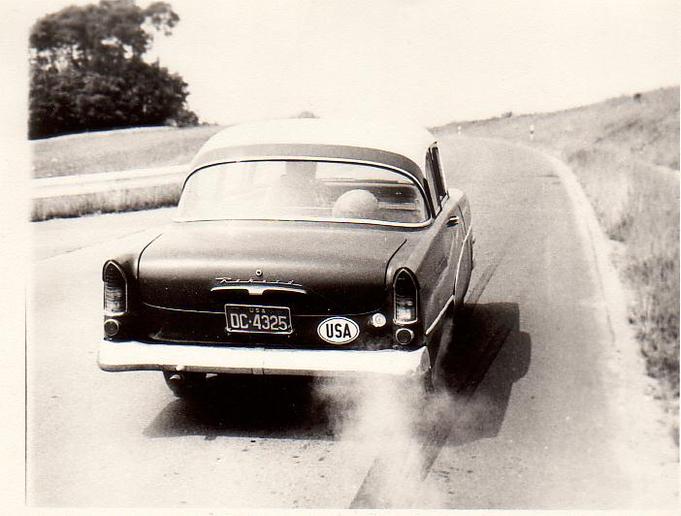OK, Cockshutt Mike asked me a question and here's my answer. First, yes, my friend was real, just as the speed I listed was real as close as I could estimate at the time. In fact the guys name was Jeff Murette. At the time we were stationed together in Charleston, SC aboard the USS William V Pratt (DDG-44)and had taken the weekend to go to Hickory to visit an extreemly HOT redhead he knew and go to a party on Sat night.
As for the speed Mike got me curious since it had been so long ago. The car got severly damaged in a towing accident in '89 and has been sitting every since so I walked out and made a few measurements and did a few calculations and thought I'd pass them on for the skeptics. One tire is off of the car and still inflated so I got a direct measured circumference of it. That measurement is 84.5 inches or 7.0416666 feet, and the rear I had in it at the time (it got changed to a 3.73 later on in life) was a 3.23 ratio as I did alot of highway driving. Just for 'because' I'm allowing myself a 500 RPM deviation on the tach and using 6000 to calculate here because I know for sure it was over 6000 and close to but maybe not all the way to 6500, but hey what's a few RPMs.
So, here goes the math----6000 RPM driveline speed / 3.23 axel ratio = 1857.5851 RPM axel speed. OK taking the axel speed of 1857.5851 RPM x the wheel circumference of 7.0416666 feet that works out to 13080.4949 FPM. Since we know that 60 MPH equals 5280 FPM you then divide 13080.4949 FPM by 5280 FPM which works out to 2.477366458. Now take 2.477366458 and multiply it by 60 and it gives you the MPH traveled at 13080.4949 FPM which works out to 148.6419875 MPH. If I did it again using all of the decimal places brought up by each equation it would probably give me another MPH or so but I think given the circumstances 148+ is good enough for here....
OK, I'll admit I was wrong about the speedo on the 55 as I checked and it pegged at 110 MPH but I know for sure the tach was reading over 6 grand as I watched it way more than I ever did the speedo. As such I know when I backed off of it and it was between 6000 and 6500. In other words the math don't lie so if I wasn't running 150 or dang close to it then I guess ya'll can all start calling by buddy Jeff by his nickname "Harvey"...LOL Like the old saying goes, OLD CHEVIES NEVER DIE, THEY JUST GO FASTER...
As for the speed Mike got me curious since it had been so long ago. The car got severly damaged in a towing accident in '89 and has been sitting every since so I walked out and made a few measurements and did a few calculations and thought I'd pass them on for the skeptics. One tire is off of the car and still inflated so I got a direct measured circumference of it. That measurement is 84.5 inches or 7.0416666 feet, and the rear I had in it at the time (it got changed to a 3.73 later on in life) was a 3.23 ratio as I did alot of highway driving. Just for 'because' I'm allowing myself a 500 RPM deviation on the tach and using 6000 to calculate here because I know for sure it was over 6000 and close to but maybe not all the way to 6500, but hey what's a few RPMs.
So, here goes the math----6000 RPM driveline speed / 3.23 axel ratio = 1857.5851 RPM axel speed. OK taking the axel speed of 1857.5851 RPM x the wheel circumference of 7.0416666 feet that works out to 13080.4949 FPM. Since we know that 60 MPH equals 5280 FPM you then divide 13080.4949 FPM by 5280 FPM which works out to 2.477366458. Now take 2.477366458 and multiply it by 60 and it gives you the MPH traveled at 13080.4949 FPM which works out to 148.6419875 MPH. If I did it again using all of the decimal places brought up by each equation it would probably give me another MPH or so but I think given the circumstances 148+ is good enough for here....
OK, I'll admit I was wrong about the speedo on the 55 as I checked and it pegged at 110 MPH but I know for sure the tach was reading over 6 grand as I watched it way more than I ever did the speedo. As such I know when I backed off of it and it was between 6000 and 6500. In other words the math don't lie so if I wasn't running 150 or dang close to it then I guess ya'll can all start calling by buddy Jeff by his nickname "Harvey"...LOL Like the old saying goes, OLD CHEVIES NEVER DIE, THEY JUST GO FASTER...



